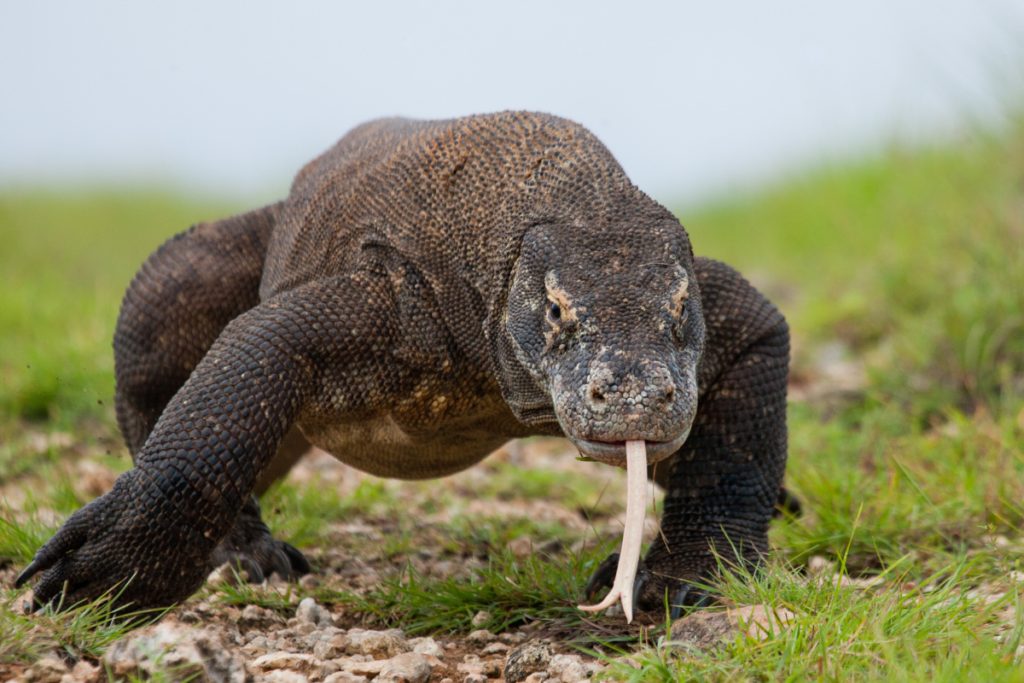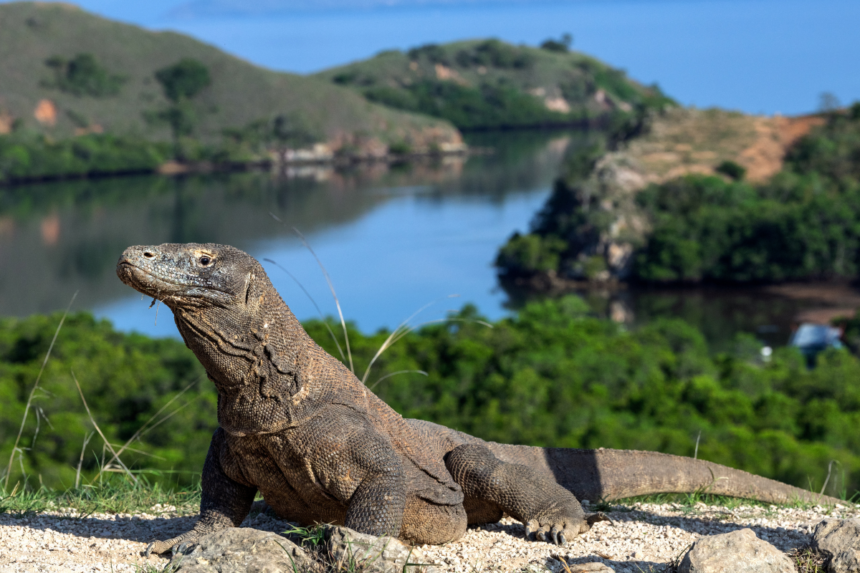Komodo dragons (Varanus komodoensis) are among the most fascinating and formidable reptiles in the world.
As the largest living lizards, they embody an ancient lineage that has adapted and survived through millions of years.
This article delves into the evolution and history of Komodo dragons, tracing their origins, exploring their physiological and behavioral adaptations, and examining their significance in the modern world.
I. Introduction: The Fascination with Komodo Dragons

The Komodo dragon, an apex predator native to the Indonesian islands, has captured the imagination of scientists and the public alike.
Its sheer size, fearsome hunting abilities, and ancient lineage make it a subject of intrigue and study.
Understanding the evolution and history of Komodo dragons provides insights into their survival and adaptation strategies, as well as their role in the broader narrative of reptilian evolution.
II. Evolutionary Origins: Tracing the Lineage

A. The Varanidae Family
Komodo dragons belong to the Varanidae family, which includes a diverse group of large, carnivorous lizards known as monitor lizards.
The Varanidae family has a rich evolutionary history, with fossil records indicating that these reptiles have existed for over 90 million years, dating back to the late Cretaceous period.
This section explores the evolutionary roots of the Varanidae family and the emergence of the genus Varanus.
B. Ancestral Giants: Megalania
One of the most significant ancestors of the Komodo dragon is Megalania (Varanus priscus), a giant monitor lizard that roamed Australia during the Pleistocene epoch.
Megalania is estimated to have reached lengths of up to 23 feet, making it one of the largest terrestrial lizards to have ever lived.
This section examines the characteristics of Megalania and its evolutionary relationship to the Komodo dragon.
C. Insular Gigantism and the Komodo Dragon
The phenomenon of insular gigantism, where species evolve to larger sizes on islands due to factors like reduced predation and competition, played a crucial role in the evolution of the Komodo dragon.
This section discusses how the isolation of the Indonesian islands contributed to the development of the Komodo dragon’s unique size and characteristics.
III. Physical Characteristics: Adaptations for Survival

A. Size and Strength
Komodo dragons can grow up to 10 feet in length and weigh over 150 pounds.
Their large size is a significant advantage in hunting and territorial dominance.
This section explores the anatomical features that contribute to their size and strength, including their muscular build, skeletal structure, and powerful limbs.
B. Sensory Adaptations
Komodo dragons possess acute senses that aid in their survival.
Their forked tongues and Jacobson’s organs allow them to detect chemical signals in the environment, effectively “tasting” the air to locate prey and identify other dragons.
Their sharp vision and sensitive hearing further enhance their ability to hunt and navigate their habitat.
This section delves into these sensory adaptations and their evolutionary advantages.
C. Venomous Bite
Recent studies have revealed that Komodo dragons have venom glands that produce toxic proteins, debunking the long-held belief that their deadly bite was solely due to bacterial infection.
The venom helps subdue prey by inducing shock, reducing blood clotting, and causing massive blood loss.
This section examines the composition of Komodo dragon venom and its role in their hunting strategy.
IV. Behavioral Adaptations: Master Predators
A. Hunting Techniques
Komodo dragons are solitary hunters that rely on stealth and ambush to capture their prey.
They can lie in wait for hours, striking with incredible speed and precision when an opportunity arises.
This section explores their hunting techniques, including their ability to take down prey much larger than themselves, such as deer and water buffalo.
B. Scavenging and Feeding Habits
In addition to hunting, Komodo dragons are opportunistic scavengers, feeding on carrion whenever available.
Their strong jaws and serrated teeth allow them to consume bones and hooves, extracting maximum nutrition from their meals.
This section discusses their feeding habits, digestive efficiency, and the ecological role of scavenging in their habitat.
C. Reproduction and Life Cycle
Komodo dragons have a unique reproductive strategy that includes both sexual reproduction and parthenogenesis, where females can produce offspring without mating.
This section explores their reproductive behavior, nesting practices, and the life cycle from hatchlings to adult dragons.
V. Ecological Significance: Guardians of Their Habitat
A. Keystone Species
As apex predators, Komodo dragons play a crucial role in maintaining the balance of their ecosystem.
By regulating the populations of herbivores and smaller predators, they help preserve the health and diversity of their habitat.
This section examines the ecological impact of Komodo dragons and their status as a keystone species.
B. Habitat and Distribution
Komodo dragons are found primarily on the islands of Komodo, Rinca, Flores, and Gili Motang in Indonesia.
Their preferred habitats range from tropical savannahs and dry forests to coastal areas.
This section discusses the distribution of Komodo dragons, their habitat preferences, and the environmental conditions that support their survival.
VI. Conservation Challenges: Protecting the Dragons
A. Threats to Survival
Despite their fearsome reputation, Komodo dragons face numerous threats that jeopardize their survival.
Habitat loss due to deforestation, human encroachment, and climate change are significant challenges.
Additionally, poaching and illegal trade pose direct threats to their population.
This section explores the various threats to Komodo dragons and the factors contributing to their endangered status.
B. Conservation Efforts
Efforts to protect Komodo dragons involve a combination of habitat preservation, anti-poaching measures, and community engagement.
Komodo National Park, established in 1980, serves as a critical sanctuary for these reptiles.
Conservation programs focus on monitoring populations, conducting research, and raising awareness about the importance of preserving Komodo dragons and their habitat.
This section highlights key conservation initiatives and their impact.
VII. Scientific Research: Unraveling the Mysteries
A. Behavioral Studies
Ongoing research into the behavior of Komodo dragons provides valuable insights into their social interactions, hunting strategies, and territorial dynamics.
Behavioral studies help scientists understand the complex nature of these reptiles and inform conservation strategies.
This section discusses recent findings from behavioral research and their implications.
B. Genetic Research
Advances in genetic research have shed light on the diversity and evolutionary history of Komodo dragons.
Genetic studies help identify distinct populations, assess genetic health, and guide breeding programs.
This section explores the role of genetic research in conservation and our understanding of Komodo dragon evolution.
VIII. Cultural Significance: Komodo Dragons in Myth and Reality
A. Mythology and Folklore
Komodo dragons have long been a part of local mythology and folklore in Indonesia.
They are often depicted as powerful and mystical creatures, embodying strength and resilience.
This section examines the cultural significance of Komodo dragons in Indonesian tradition and how they are perceived by local communities.
B. Modern Symbolism
Today, Komodo dragons are symbols of Indonesia’s natural heritage and biodiversity.
They attract tourists from around the world, contributing to the local economy and raising awareness about conservation.
This section discusses the role of Komodo dragons in modern culture and their importance as conservation icons.
IX. The Future of Komodo Dragons: Challenges and Opportunities
A. Climate Change and Habitat Preservation
Climate change poses a significant threat to the habitat of Komodo dragons, affecting temperature, precipitation patterns, and sea levels.
Preserving and restoring their natural habitats is crucial for their survival.
This section explores the impact of climate change on Komodo dragons and the importance of habitat preservation.
B. Community Involvement and Education
Engaging local communities in conservation efforts is essential for the success of initiatives aimed at protecting Komodo dragons.
Education and awareness programs can foster a sense of stewardship and encourage sustainable practices.
This section highlights the role of community involvement in conservation and the benefits of educational outreach.
X. Conclusion: The Legacy of Komodo Dragons
Komodo dragons, ancient reptiles that have survived through millions of years of evolutionary change, are a testament to nature’s resilience and adaptability.
Their unique characteristics, ecological significance, and cultural impact make them one of the most extraordinary species on the planet.
By understanding their evolution and history, we can appreciate the challenges they face and the importance of conserving these magnificent creatures for future generations.
The story of the Komodo dragon is not just a tale of survival but a reflection of the intricate web of life that sustains our planet.
Protecting them is a reminder of our responsibility to preserve the natural world and the diverse species that inhabit it.
As we continue to unveil the mysteries of these ancient predators, we are reminded of the beauty and complexity of the natural world and our role in its stewardship.






